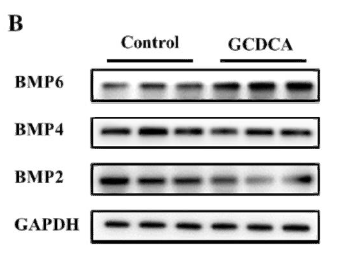BMP-4 rabbit pAb
- Catalog No.:YT7841
- Applications:WB;ELISA
- Reactivity:Human;Rat;Mouse;
- Target:
- BMP-4
- Fields:
- >>Cytokine-cytokine receptor interaction;>>TGF-beta signaling pathway;>>Hippo signaling pathway;>>Signaling pathways regulating pluripotency of stem cells;>>Thyroid hormone signaling pathway;>>Pathways in cancer;>>Basal cell carcinoma;>>Fluid shear stress and atherosclerosis
- Gene Name:
- BMP4 BMP2B DVR4
- Protein Name:
- BMP-4
- Human Gene Id:
- 652
- Human Swiss Prot No:
- P12644
- Mouse Gene Id:
- 12159
- Mouse Swiss Prot No:
- P21275
- Rat Swiss Prot No:
- Q06826
- Immunogen:
- Synthesized peptide derived from human BMP-4 AA range: 261-310
- Specificity:
- This antibody detects endogenous levels of Human BMP-4
- Formulation:
- Liquid in PBS containing 50% glycerol, 0.5% BSA and 0.02% sodium azide.
- Source:
- Polyclonal, Rabbit,IgG
- Dilution:
- WB 1:1000-2000 ELISA 1:5000-20000
- Purification:
- The antibody was affinity-purified from rabbit antiserum by affinity-chromatography using epitope-specific immunogen.
- Concentration:
- 1 mg/ml
- Storage Stability:
- -15°C to -25°C/1 year(Do not lower than -25°C)
- Other Name:
- Bone morphogenetic protein 4 (BMP-4;Bone morphogenetic protein 2B;BMP-2B)
- Molecular Weight(Da):
- 45kD
- Background:
- disease:Defects in BMP4 are the cause of microphthalmia syndromic type 6 (MCOPS6) [MIM:607932]; also known as microphthalmia and pituitary anomalies or microphthalmia with brain and digit developmental anomalies. Microphthalmia is a clinically heterogeneous disorder of eye formation, ranging from small size of a single eye to complete bilateral absence of ocular tissues (anophthalmia). In many cases, microphthalmia/anophthalmia occurs in association with syndromes that include non-ocular abnormalities. MCOPS6 is characterized by microphthalmia/anophthalmia associated with facial, genital, skeletal, neurologic and endocrine anomalies.,function:Induces cartilage and bone formation. Also act in mesoderm induction, tooth development, limb formation and fracture repair.,online information:Bone morphogenetic protein 4 entry,similarity:Belongs to the TGF-beta family.,subunit:Homodimer; disulfide-linked (By similarity). Interacts with GREM2 (By similarity) and SOSTDC1. Part of a complex consisting of TWSG1 and CHRD.,tissue specificity:Expressed in the lung and lower levels seen in the kidney. Present also in normal and neoplastic prostate tissues, and prostate cancer cell lines.,
- Function:
- skeletal system development, ossification, angiogenesis, ovarian follicle development, blood vessel development,osteoblast differentiation, eye development, urogenital system development, metanephros development, ureteric bud development, branching involved in ureteric bud morphogenesis, formation of primary germ layer, mesoderm formation, cell fate specification, cell fate determination, mesodermal cell fate commitment, induction of an organ,morphogenesis of a branching structure, kidney development, regulation of protein amino acid phosphorylation,positive regulation of protein amino acid phosphorylation, vasculature development, morphogenesis of an epithelium,lens development in camera-type eye, lens morphogenesis in camera-type eye, immune system development,regionalization, reproductive developmental process, regulation of transcription, DNA-dependent, regulation of transcription fr
- Subcellular Location:
- Secreted, extracellular space, extracellular matrix.
- Expression:
- Expressed in the lung and lower levels seen in the kidney. Present also in normal and neoplastic prostate tissues, and prostate cancer cell lines.
Glycochenodeoxycholate Affects Iron Homeostasis via Up-Regulating Hepcidin Expression Nutrients Long-jiao Wang WB Mouse
- June 19-2018
- WESTERN IMMUNOBLOTTING PROTOCOL
- June 19-2018
- IMMUNOHISTOCHEMISTRY-PARAFFIN PROTOCOL
- June 19-2018
- IMMUNOFLUORESCENCE PROTOCOL
- September 08-2020
- FLOW-CYTOMEYRT-PROTOCOL
- May 20-2022
- Cell-Based ELISA│解您多样本WB检测之困扰
- July 13-2018
- CELL-BASED-ELISA-PROTOCOL-FOR-ACETYL-PROTEIN
- July 13-2018
- CELL-BASED-ELISA-PROTOCOL-FOR-PHOSPHO-PROTEIN
- July 13-2018
- Antibody-FAQs
- Products Images

- Glycochenodeoxycholate Affects Iron Homeostasis via Up-Regulating Hepcidin Expression Nutrients Long-jiao Wang WB Mouse


